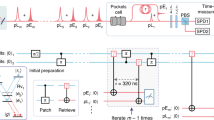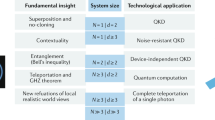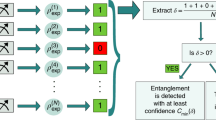Abstract
The creation of increasingly large multipartite entangled states is not only a fundamental scientific endeavour in itself1,2,3, but is also the enabling technology for quantum information4,5. Tremendous experimental effort has been devoted to generating multiparticle entanglement with a growing number of qubits6,7,8,9,10,11,12,13,14,15,16. So far, up to six spatially separated single photons10,11,12,13,14 have been entangled based on parametric downconversion17. Multiple degrees of freedom of a single photon have been exploited to generate forms of hyper-entangled states18,19. Here, using new ultra-bright sources of entangled photon pairs20, an eight-photon interferometer and post-selection detection, we demonstrate for the first time the creation of an eight-photon Schrödinger cat state1 with genuine multipartite entanglement. The ability to control eight individual photons represents a step towards optical quantum computation, and will enable new experiments on, for example, quantum simulation21,22, topological error correction23 and testing entanglement dynamics under decoherence24.
This is a preview of subscription content, access via your institution
Access options
Subscribe to this journal
Receive 12 print issues and online access
$209.00 per year
only $17.42 per issue
Buy this article
- Purchase on Springer Link
- Instant access to full article PDF
Prices may be subject to local taxes which are calculated during checkout



Similar content being viewed by others
References
Schrödinger, E. Die Gegenwartige Situation in der Quantenmechanik. Naturwissenschaften 23, 807–812, 823–828, 844–849 (1935).
Einstein, A., Podolsky, B. & Rosen, N. Can quantum-mechanical description of physical reality be considered complete? Phys. Rev. 47, 777–780 (1935).
Leggett, A. J. Realism and the physical world. Rep. Prog. Phys. 71, 022001 (2008).
Zoller, P. et al. Quantum information processing and communication. Eur. Phys. J. D 36, 203–228 (2005).
Ladd, T. D. et al. Quantum computers. Nature 464, 45–53 (2010).
Bouwmeester, D., Pan, J.-W., Daniell, M., Weinfurter, H. & Zeilinger, A. Observation of three-photon Greenberger–Horne–Zeilinger entanglement. Phys. Rev. Lett. 82, 1345–1349 (1999).
Sackett, C. A. et al. Experimental entanglement of four particles. Nature 404, 256–259 (2000).
Zhao, Z. et al. Experimental demonstration of five-photon entanglement and open-destination teleportation. Nature 430, 54–58 (2004).
Häffner, H. et al. Scalable multiparticle entanglement of trapped ions. Nature 438, 643–646 (2005).
Lu, C.-Y. et al. Experimental entanglement of six photons in graph states. Nature Phys. 3, 91–95 (2007).
Prevedel, R. et al. Experimental realization of Dicke states of up to six qubits for multiparty quantum networking. Phys. Rev. Lett. 103, 020503 (2009).
Wieczorek, W. et al. Experimental entanglement of a six-photon symmetric Dicke state. Phys. Rev. Lett. 103, 020504 (2009).
Radmark, M., Zukowski, M. & Bourennane, M. Experimental test of fidelity limits in six-photon interferometry and of rotational invariance properties of the photonic six-qubit entanglement singlet state. Phys. Rev. Lett. 103, 150501 (2009).
Matthews, J. C. F., Politi, A., Bonneau, D. & O'Brien, J. L. Heralded entanglement for quantum enhanced measurement with photons. Phys. Rev. Lett. 107, 163602 (2011).
Krischek, R. et al. Ultraviolet enhancement cavity for ultrafast nonlinear optics and high-rate multiphoton entanglement experiments. Nature Photon. 4, 170–173 (2010).
Monz, T. et al. 14-Qubit entanglement: creation and coherence. Phys. Rev. Lett. 106, 130506 (2011).
Kwiat, P. G. et al. New high-intensity source of polarization-entangled photon pairs. Phys. Rev. Lett. 75, 4337–4341 (1995).
Barreiro, J. T., Langford, N. K., Peter, N. A. & Kwiat, P. G. Generation of hyperentangled photon pairs. Phys. Rev. Lett. 95, 260501 (2005).
Gao, W.-B., et al. Experimental demonstration of a hyper-entangled ten-qubit Schrödinger cat state. Nature Phys. 6, 331–335 (2010).
Kim, Y.-H., Kulik, S. P., Chekhova, M. V., Grice, W. P. & Shih, Y. Experimental entanglement concentration and universal Bell-state synthesizer. Phys. Rev. A 67, 010301 (2003).
Lanyon, B. P. et al. Towards quantum chemistry on a quantum computer. Nature Chem. 2, 106–111 (2010).
Ma, X.-S., Dakic, B., Naylor, W., Zeilinger, A. & Walther, P. Quantum simulation of the wavefunction to probe frustrated Heisenberg spin systems. Nature Phys. 7, 399–405 (2011).
Raussendorf, R., Harrington, J. & Goyal, K. Topological fault-tolerance in cluster state quantum computation. New J. Phys. 9, 199 (2007).
Barreiro, J. T. et al. Experimental multiparticle entanglement dynamics induced by decoherence. Nature Phys. 6, 943–946 (2010).
Greenberger, D. M., Horne, M., Shimony, A. & Zeilinger, A. Bell's theorem without inequalities. Am. J. Phys. 58, 1131–1143 (1990).
Barbieri, M. et al. Parametric down conversion and optical quantum gates: two's company, four's a crowd. J. Mod. Opt. 56, 209–214 (2009).
Weinhold, T. J. et al. Understanding photonic quantum-logic gates: the road to fault tolerance. Preprint at http://arXiv.org/abs/0808.0794 (2008).
Keller, T. E. & Rubin, M. H. Theory of two-photon entanglement for spontaneous parametric down-conversion driven by a narrow pump pulse. Phys. Rev. A 56, 1534–1541 (1997).
Grice, W. P. & Walmsley, I. A. Spectral information and distinguishability in type-II down-conversion with a broadband pump. Phys. Rev. A 56, 1627–1634 (1997).
Mosley, P. J. et al. Heralded generation of ultrafast single photons in pure quantum states. Phys. Rev. Lett. 100, 133601 (2008).
Hein, M., Eisert, J. & Briegel, H. J. Multiparty entanglement in graph states. Phys. Rev. A 69, 062311 (2004).
Bouwmeester, D. et al. Experimental quantum teleportation. Nature 390, 575–579 (1997).
Bourennane, M. et al. Experimental detection of multipartite entanglement using witness operators. Phys. Rev. Lett. 92, 087902 (2004).
Acknowledgements
The authors thank M. Cramer for useful discussions. This work was supported by the National Natural Science Foundation of China, the Chinese Academy of Sciences and the National Fundamental Research Program (grant no. 2011CB921300).
Author information
Authors and Affiliations
Contributions
X.-C.Y., X.-H.B., Y.-A.C. and J.-W.P. conceived and designed the research. X.-C.Y., T.-X.W., P.X., H.L., G.-S.P. and C.-Z.P. carried out the experiment. X.-H.B. programmed the FPGA logic. C.-Y.L. contributed theoretical analysis tools. X.-C.Y. and Y.-A.C. analysed the data. X.-C.Y., C.-Y.L., Y.-A.C. and J.-W.P. wrote the manuscript. C.-Y.L., Y.-A.C. and J.-W.P. supervised the project.
Corresponding authors
Ethics declarations
Competing interests
The authors declare no competing financial interests.
Supplementary information
Supplementary information
Supplementary information (PDF 229 kb)
Rights and permissions
About this article
Cite this article
Yao, XC., Wang, TX., Xu, P. et al. Observation of eight-photon entanglement. Nature Photon 6, 225–228 (2012). https://doi.org/10.1038/nphoton.2011.354
Received:
Accepted:
Published:
Issue Date:
DOI: https://doi.org/10.1038/nphoton.2011.354
This article is cited by
-
Quantum hyper-entangled system with multiple qubits based on spontaneous parametric down-conversion and birefringence effect
Optical and Quantum Electronics (2024)
-
Quantum MDS and synchronizable codes from cyclic codes of length \(5p^s\) over \(\mathbb F_{p^m}\)
Applicable Algebra in Engineering, Communication and Computing (2023)
-
Optimal constructions of quantum and synchronizable codes from repeated-root cyclic codes of length \(3p^s\)
Quantum Information Processing (2023)
-
Experimental implementation of secure anonymous protocols on an eight-user quantum key distribution network
npj Quantum Information (2022)
-
Bidirectional Controlled Quantum Teleportation of Arbitrary Two-qubit States Using Ten-qubit Entangled Channel in Noisy Environment
International Journal of Theoretical Physics (2022)



